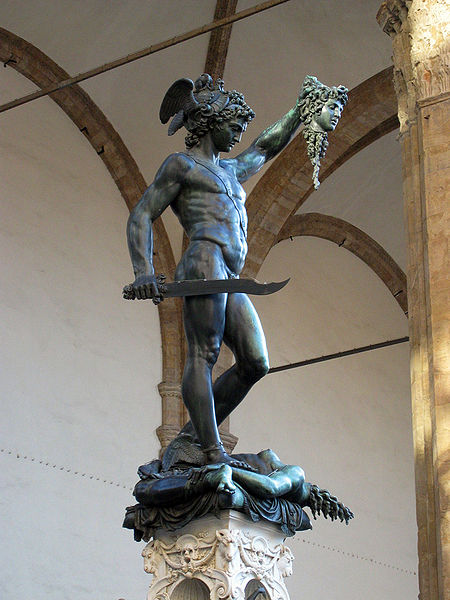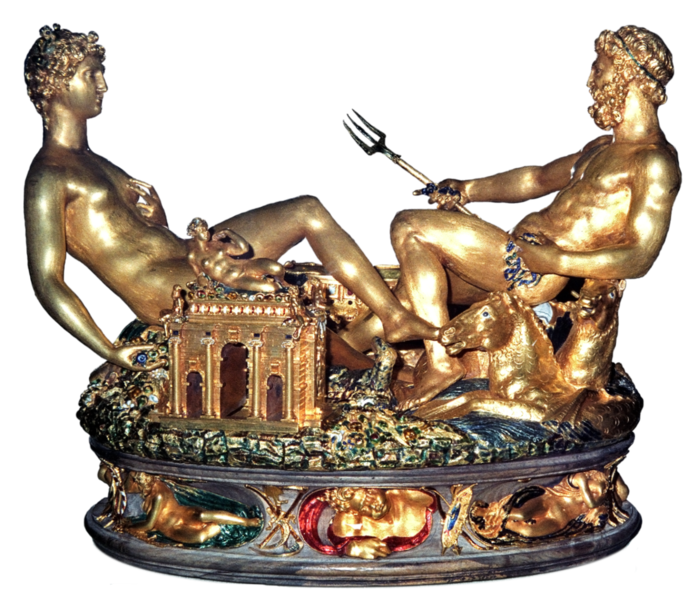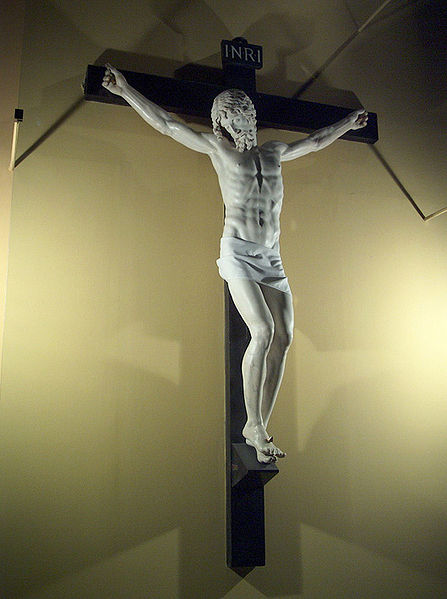<Back to Index>
- Physician Bernardino Ramazzini, 1633
- Sculptor Benvenuto Cellini, 1500
- Dictator of Paraguay Alfredo Strössner Matiauda, 1912
PAGE SPONSOR

Benvenuto Cellini (3 November 1500 – 13 February 1571) was an Italian goldsmith, sculptor, painter, soldier and musician, who also wrote a famous autobiography. He was one of the most important artists of Mannerism.
Benvenuto Cellini was born in Florence, Italy. His parents were Giovanni Cellini, and Maria Lisabetta Granacci. They were married for eighteen years before the birth of their first child. Benvenuto was the second child of the family. The son of a musician and builder of musical instruments, Cellini's first major brush with the law came as an early teenager: He was banished from his native Florence for his alleged role in a brawl. As a result, he received his early artistic training not only from the Florentine goldsmith Marcone [Antonio di Sandro], but also from Francesco Castoro, a goldsmith of Siena. After further visits to Bologna and Pisa, Cellini was allowed to return to Florence and continue his work there.
Giovanni initially wished Benvenuto to join him in instrument making, and endeavoured to thwart his inclination for metalwork. When he was fifteen, his father reluctantly agreed to apprentice him to a goldsmith, Antonio di Sandro, nicknamed Marcone. At the age of sixteen, Benvenuto had already attracted attention in Florence by taking part in an affray with youthful companions. He escaped punishment by fleeing for six months to Siena, where he worked for a goldsmith named Fracastoro (unrelated to the Veronese polymath). From Siena he moved to Bologna, where he became a more accomplished flute player and made progress as a goldsmith. After a visit to Pisa and two periods of living in Florence (where he was visited by the sculptor Torrigiano), he moved to Rome, age nineteen.
His
first works in Rome were a silver casket, silver candlesticks,
and a vase for the bishop of
Salamanca, which won him the approval of Pope Clement VII.
Another celebrated work from Rome is the gold medallion of "Leda and the
Swan" executed for the Gonfaloniere Gabbriello Cesarino, and
which is now in the Vienna museum.
He also took up the flute again, and was appointed one of the pope's
court musicians. In the attack upon Rome by Charles III,
Duke of Bourbon, Cellini's bravery proved of signal service to
the pontiff.
According to his own accounts, he himself shot and injured Philibert of
Châlon, prince of Orange. (Allegedly Cellini also killed Charles III,
Duke of Bourbon during
the Siege of Rome.) His bravery led to a reconciliation with the
Florentine magistrates, and he soon returned to his
hometown. Here he devoted himself to crafting medals, the most famous
of which are "Hercules and the Nemean Lion", in gold repoussé work, and "Atlas supporting the Sphere", in
chased gold, the latter eventually falling into the possession of Francis I of
France. From Florence he went to the court of the
duke of Mantua, and then again to Florence. On
returning to Rome, he was employed in the working of jewellery and in the execution of dies for private
medals and for the papal
mint.
In 1529 his brother Cecchino killed a Corporal of the Roman Watch and
in turn was wounded by an arquebusier, later dying of his wound. Soon
afterward Benvenuto killed his brother's killer – an act of blood
revenge but not justice as Cellini admits that
his brother's killer had acted in self-defense. Cellini fled to Naples to shelter from the consequences of an
affray with a notary, Ser Benedetto, whom he had wounded.
Through the influence of several cardinals, Cellini obtained a pardon. He found
favor with the new pope,Paul
III, notwithstanding a fresh
homicide during the interregnum three
days after the death of Pope Clement VII in September 1534. The fourth
victim was a rival goldsmith who was working under Cellini's
employment; Pompeo of Milan. Cellini reported in his autobiography that
he had fallen in love with Pompeo and admired watching his magnificent
physique as he worked near the furnace melting iron and bronze, and
that he bore the hope of his affections to soon be acknowledged and
returned by Pompeo. When Cellini learned that Pompeo was absent from
work that day as his wife's lover, he admitted to visiting the Villa
where his separated wife lived and meeting Pompeo at the door, stabbed
him on the threshold. His wife he immediately stabbed afterward inside
of the home for her 'betrayal'. The killings, the fourth and fifth that
Cellini boasts of in his memoirs, was reported in his autobiography as
nothing more than a 'justifiable accident during a heated argument'
rather than by premeditated malice. He was saved from arrest only
because of a safe-conduct by the Pope. The
plots of Pierluigi
Farnese led to
Cellini's retreat from Rome to Florence and Venice,
where he was restored with greater honour than before. At the age of
37, upon returning from a visit to the French court, he was imprisoned
on a charge (apparently false) of having embezzled during the war the
gems of the pope's tiara.
He was confined in the Castel Sant'
Angelo,
escaped, was recaptured, and treated with great severity, and was in
daily expectation of death on the scaffold. The intercession of
Pierluigi's wife, and especially that of the Cardinal d'Este of Ferrara,
eventually secured Cellini's release, in gratitude for which he gave
d'Este a splendid cup. Cellini then worked at the court of
Francis I at Fontainebleau and Paris. However, he considered the duchesse
d'Étampes to
be set against him and refused to conciliate with the king's favorites.
He could no longer silence his enemies by the sword, as he had silenced
those in Rome. As a result, after about five years of invested work but
continual jealousy and violence, Cellini returned to Florence, where he
continued as a goldsmith and became the rival of sculptor
Baccio Bandinelli, who died a few years later in 1560.
During
the war with Siena, Cellini was appointed to strengthen the defences of
his native city, and, though rather shabbily treated by his ducal
patrons, he continued to gain the admiration of his fellow citizens by
the magnificent works which he produced. He was also named a member (Accademico)
of the prestigious Accademia delle
Arti del Disegno of
Florence, founded by the Duke Cosimo I de'
Medici, at 13 January 1563, under the influence of the architect Giorgio Vasari.
He died in Florence in 1571 and was buried with great pomp in the
church of the Santissima Annunziata. He had supported in Florence a
widowed sister and her six daughters. Cellini
is known to have taken some of his female models as mistresses, having
an illegitimate daughter in 1544 with one of them while living in
France, whom he named Costanza. After
briefly attempting a clerical career, in 1562, he married a servant,
Piera Parigi, with whom he claimed he had five children, of which only
a son and two daughters survived him. Outside his marriage, Cellini was
officially charged or accused three times with homosexual sodomy and once with heterosexual. Towards the end of his life during a
public altercation before Duke Cosimo, Bandinelli had called out to him Sta cheto, soddomitaccio! (Shut up, you filthy sodomite!) Cellini
qualified it an "atrocious insult." Besides
his works in gold and silver, Cellini executed sculptures of grander scale. The most
distinguished of these is the bronze group of Perseus with
the Head of Medusa, a work (first suggested by Duke Cosimo I de
Medici) now in the Loggia dei Lanzi at Florence, his attempt to
surpass Michelangelo's David and Donatello's Judith and
Holofernes.
The casting of this work caused Cellini much trouble and anxiety, but
it was hailed as a masterpiece as soon as it was completed. The
original relief from the foot of the pedestal — Perseus and Andromeda
— is in the Bargello,
and replaced by a cast. By 1996,
centuries of environmental pollution exposure had streaked and banded the
statue. In December of that year it was removed from the Loggia and
transferred to the Uffizi for
cleaning and restoration. It was a slow, years long process, and the
restored statue was not returned to its home until June 2000. Among
his art works, many of which have perished, were a colossal Mars for a fountain at
Fontainebleau and the bronzes of the doorway, coins for the Papal and
Florentine states, a life-sized silver Jupiter,
and a bronze bust of Bindo
Altoviti. The works of decorative art are florid in style. In
addition to the bronze statue of Perseus and the medallions already
referred to, the works of art in existence today are a medallion of Clement
VII commemorating
the peace between the Christian princes, 1530, with a bust of the pope
on the reverse and a figure of Peace setting fire to a heap of arms in
front of the temple of Janus, signed with the artist's name; a signed
portrait medal of Francis; a medal of Cardinal Pietro
Bembo; and the celebrated
gold, enamel and ivory salt cellar (known as Saliera)
made for Francis I of France at Vienna. This intricate 26 cm-high
sculpture, of a value conservatively estimated at 58,000,000 schilling,
was commissioned by Francis I. Its principal figures are a naked sea
god and a woman sitting opposite each other with legs entwined,
symbolically representing the planet Earth. "Saliera" was stolen from
the Kunsthistorisches
Museum on
11 May 2003 by a thief who climbed a scaffolding and smashed the
windows to
enter the museum. The thief set off the alarms, but these were ignored
as false, and the theft remained undiscovered until 8:20 AM. On 21
January 2006 the Saliera was
recovered by the Austrian police and is supposed to be returned to the
Kunsthistorisches Museum in the coming days. One of the most important
works by Cellini from late in his career was a life-size nude crucifix
carved from marble. Although originally intended to be placed over his
tomb, this crucifix was sold to the Medici family who gave it to Spain.
Today the crucifix is in the Escorial Monastery
near Madrid, where it has usually been displayed in an altered form —
the
monastery added a loincloth and a crown of thorns. Cellini, while
employed
at the papal mint at Rome during the papacy of Clement VII and later of
Paul III, created the dies of several coins and medals, some of which
still survive at this now defunct mint. He was also in the service of
Alessandro de Medici,
first duke of Florence, for whom he made in 1535 a forty-soldi piece
with a bust of the duke on one side and standing figures of the saints Cosima
and Damian on the other. Some connoisseurs attribute to his hand
several plaques, "Jupiter crushing the Giants", "Fight between Perseus
and Phineus",
a Dog, etc. Other works are not
directly attributed to him but are instead attributed to his workshop. The important works which have perished
include the uncompleted chalice intended for Clement VII; a gold cover
for a prayer book as a gift from Pope Paul III to Charles
V, Holy Roman Emperor – both described at length in his
autobiography; large silver statues of Jupiter, Vulcan and Mars, wrought for Francis I during
his sojourn in Paris; a bust of Julius
Caesar; and a silver cup for
the cardinal
of Ferrara. The magnificent
gold "button", or morse (a clasp for a cape), made by
Cellini for the cape of Clement VII, the competition for which is so
graphically described in his autobiography, appears to have been
sacrificed by Pope
Pius VI, with many other
priceless specimens of the goldsmith's art, in furnishing the
30,000,000 francs demanded by Napoleon
I at the conclusion of the campaign against
the Papal
States in
1797. According to the terms of the treaty, the pope was permitted to
pay a third of that sum in plate and jewels. Fortunately there are in
the print room of the British
Museum three
watercolour drawings
of this splendid morse by F. Bertoli, done at the instance of an
Englishman named Talman in the first half of the 18th century. The
obverse and reverse, as well as the rim, are drawn full size, and
moreover the morse with the precious stones set therein, including a
diamond then considered the second largest in the world, is fully
described. Benvenuto's works are mentioned as "priceless" in Mark
Twain's The Prince and
the Pauper.



